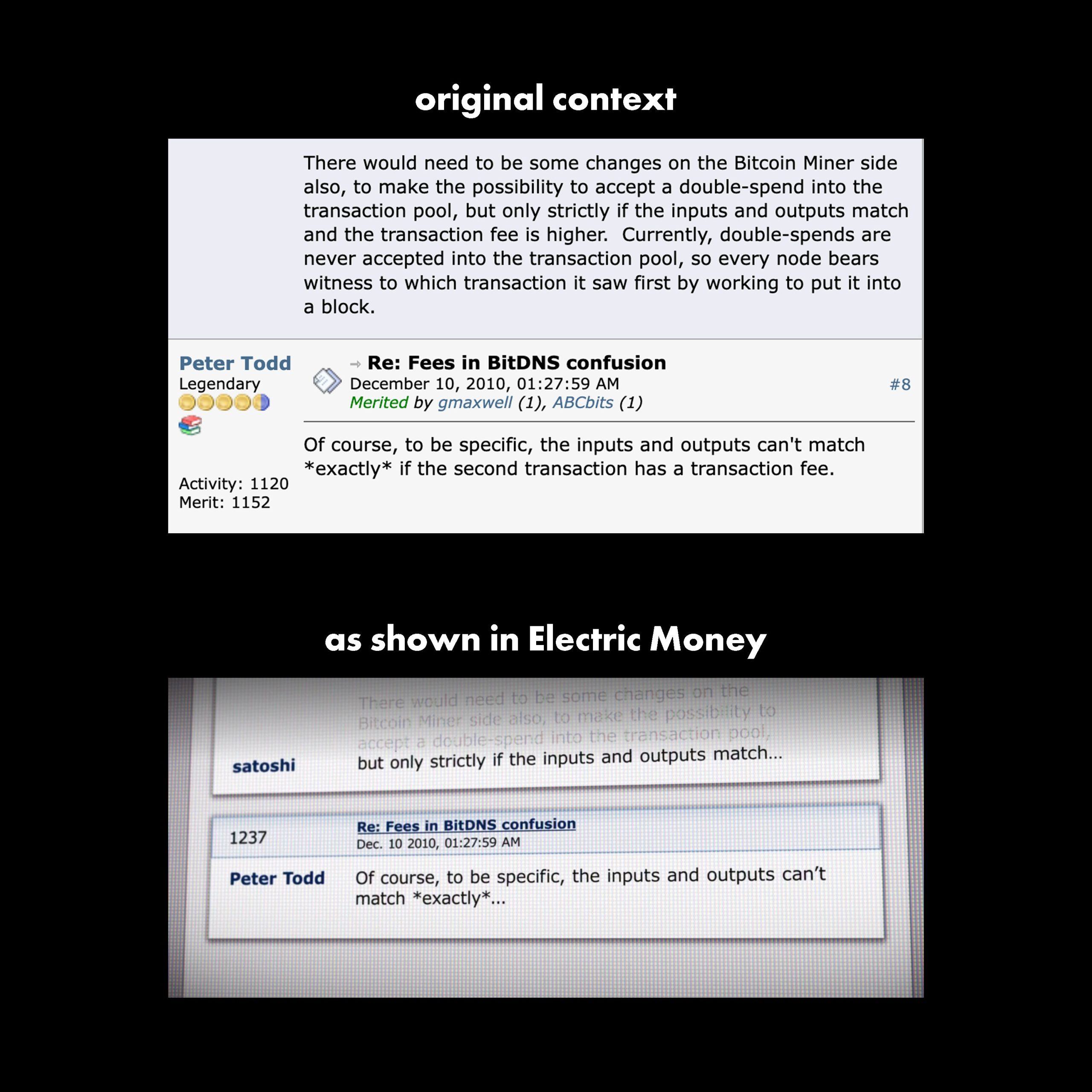This week, the documentary “Money Electric,” directed by Cullen Hoback, floated the idea that software developer Peter Todd could be the real identity behind Bitcoin’s creator, Satoshi Nakamoto. The film dives into a few theories suggesting why Hoback thinks the 39-year-old Canadian programmer may have invented Bitcoin. If true, Todd would have been just 23 when Satoshi released the groundbreaking Bitcoin white paper on Oct. 31, 2008.
The filmmaker argues that Todd likely used the pseudonym “Satoshi Nakamoto” to lend credibility to the project, considering a young 23-year-old might not have been taken as seriously. The documentary goes on to claim that Todd unintentionally revealed his identity by posting on bitcointalk.org as Satoshi. However, this scene is quite misleading—the film’s depiction of the forum post is edited, and the real thread looks completely different.

Source: @markus_hartley
One supposed piece of evidence is Todd’s controversial conversation with a self-identified intelligence agent, John Dillon. This info came to Hoback through an interview with Bitcoin.com’s founder Roger Ver. The discussion between Dillon and Todd largely revolves around Bitcoin’s development, privacy, security, and decentralization. At one point, Dillon asks Todd to sign his PGP key, raising questions about verifying identities in decentralized systems.
Dillon, wishing to stay anonymous, uses the alias “Bitcoin John Dillon” and claims the usual PGP trust system doesn’t apply to him. Todd agrees to sign the key, and the two reflect on the importance of anonymity in Bitcoin, noting that Satoshi remained pseudonymous to keep decisions free from external pressure.
The conversation then shifts to more technical matters, particularly Todd’s work on “replace-by-fee (RBF),” a feature allowing transactions to be replaced with higher-fee versions for quicker confirmations. They brainstorm ways to make RBF more user-friendly and discuss countermeasures for denial-of-service (DoS) attacks. Both express concerns about maintaining Bitcoin’s decentralized nature while ensuring it can scale. Todd shares his view that Bitcoin’s 1MB block size limit, while not immediately problematic, could become an issue as the network grows.
Dillon also brings up concerns about SPV (Simplified Payment Verification) nodes, which only partially validate transactions, possibly introducing risks. They explore using peer-to-peer (P2P) messaging with anti-DDoS mechanisms and discuss improving Bitcoin’s core features, such as faster block header propagation and decentralized mining infrastructure. Although Dillon didn’t explicitly offer $500 as a reward for developing RBF during this chat, even though the movie mentions this, he later bumped the reward to $1,000 as an incentive for Todd’s work. Dillon mentioned his bitcoins were temporarily inaccessible due to travel but promised to send 1 BTC soon.
Interestingly, Hoback speculates that Dillon and Todd might be the same person. Todd eventually completed RBF, and it was integrated into Bitcoin’s codebase, where it remains today.

Another piece of so-called ‘evidence’ cited by the documentary is that Satoshi never returned to bitcointalk.org after the thread with Todd appearing on the forum. Additionally, Hoback references a cryptic post where Todd supposedly talked about destroying cryptocurrency, although the film leaves out that Todd participated in Zcash’s trusted setup ceremony. This event, dubbed the “Sprout” ceremony, involved six people, including Todd, who helped generate the public parameters needed for Zcash’s private transactions.
While Todd was involved in the Sprout ceremony, he later criticized parts of the process, showing he wasn’t fully satisfied with Zcash’s implementation and security measures. The ceremony relied on the destruction of private key shards by its participants to ensure no one could recreate the “toxic waste” private key.
After the documentary aired on HBO, Todd went on X to say, “I’m not Satoshi.” The film was heavily criticized for its shaky journalism and baseless theories. One X user, Pledditor, called it “one of the least compelling Satoshi Nakamoto identities I’ve ever seen,” accusing the filmmaker of recklessly accusing Todd without any real proof. Pledditor added, “Peter was right, this documentary is garbage and shameful.” Others chimed in, criticizing Todd for basking in the attention.
“By simple virtue of the fact that Peter Todd is eating up the attention and begging for more, he doesn’t deserve to be mentioned in the same context as Satoshi Nakamoto,” Justin Belcher said. “It’s really rather pathetic and embarrassing, isn’t it?”
“What a bust,” said Cinneamhain Ventures partner Adam Cochran. “Wild speculation, lacks understanding of the tech that rules it out, no smoking gun. And irresponsibly names someone as Satoshi, who is alive today, says they aren’t Satoshi, and does so without solid proof.”
免责声明:本文章仅代表作者个人观点,不代表本平台的立场和观点。本文章仅供信息分享,不构成对任何人的任何投资建议。用户与作者之间的任何争议,与本平台无关。如网页中刊载的文章或图片涉及侵权,请提供相关的权利证明和身份证明发送邮件到support@aicoin.com,本平台相关工作人员将会进行核查。



